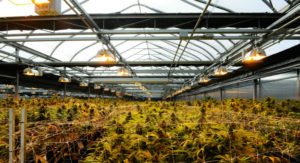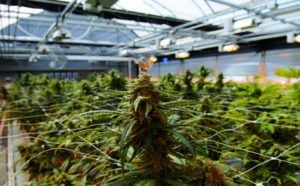
How to Build a Greenhouse for Cannabis Production
The title of this article is a bit of a misnomer, since there isn’t a single cookie cutter greenhouse structure for cannabis growing as there is not a specific unique poinsettia greenhouse, or only one way to grow perennials. Nevertheless there are some aspects of greenhouse construction that most marijuana growers will want to include to provide the best environment for their crop.
With any greenhouse design, it is important to keep the end purpose in mind right from the start. Greenhouses are built to provide your crop, whatever it is, with the ideal growing environment. If you are growing annuals or perennials you may need to build some flexibility in your greenhouse design to accommodate different plants with different climatic needs. If you are only growing tomatoes, your greenhouse can be designed built to focus entirely on maximizing production efficiencies and yield of that plant.
Marijuana is a controlled substance, so assuming you have jumped through all the regulatory hoops to be awarded one of the coveted cultivation licenses, it is unlikely that your marijuana greenhouse will grow any plants outside the cannabis family. So for growing marijuana plants, you want to focus on the ideal environment for cannabis.
The 4 Stages of Growth for Cannabis Production Affect How You Zone Your Greenhouse
Zone 1: Marijuana mother plants
Zone 2: Marijuana clones (cuttings)
Zone 3: Marijuana in the vegetative stage
Zone 4: Marijuana in the flower stage
 Plan for Expansion From the Start
Plan for Expansion From the Start
If you are already growing crops successfully in a greenhouse, it is easy to focus your cannabis business energies on the crop growing side. But losing sight of this as a whole new business with different customers and different distribution channels will get you in trouble. Start your cannabis greenhouse sized for your near future customer demands but with scalability in mind to accommodate your longer term business goals. We work with growers all over the world designing greenhouses for multiple stage expansion plans. A little extra time at the beginning can save you months of headaches and additional costs down the road.
Balance Production Efficiencies
Marijuana growers are used to growing in smaller spaces than most commercial growers. Greenhouse structures and modern horticultural growing technology offer enormous production benefits compared to typical indoor growing. But where large zones increase production efficiency, they also increase crop risk from disease or infestation spreading. When you consider the monetary value of your marijuana crop, and possibly the medical imperative of providing consistent medication to your patients, there is a reasonable tradeoff between production scale zones and isolation segmenting.
Zone segmentation can easily be achieved with inside gable walls and sidewalls, a properly designed greenhouse heating and cooling system and good environmental controls. Blackout curtains (also known as light deprivation screens), irrigation, and fertigation systems are all designed by greenhouse industry experts to be centrally controlled for multiple zones.
Building the Ideal Environment
1. Geographic location. I cannot overstress the importance of this point. Not all greenhouse manufacturers or cannabis growing consultants have experience in different geographical locations. Many people will try and sell you the greenhouse that has been successful in Colorado, but if you are in Southern California, Puerto Rico, or Alaska, the greenhouse you need is going to be very different.
Your outside temperature fluctuations, wind speeds, humidity levels, snow loads, and light levels all factor into what equipment and the style of structure that is best for you and your crop.
2. Inside greenhouse temperature. Cannabis like many crops likes different temperatures at different stages of growth. As a generalization you want your greenhouse temperatures between 65 to 85° F. Your greenhouse heating and cooling systems need to consider the temperature needs and controls for each zone. Inexperienced consultants may tell you that you don’t need as much heating because the lights generate a lot of heat, but as you will see in the sections below, cannabis typically wants only 18 or 12 hours of light, so your coldest night time temperatures will still typically have no lights on at all.
3. Managing humidity inside a cannabis greenhouse. We all know the effects humidity has on plants. Too much, and you invite disease, too little and you dry out the plant and hinder growth. As with any crop, knowing the humidity that the plant thrives in is important when designing a greenhouse. While cannabis in the vegetative stage actually likes a higher humidity level, it prefers lower humidity when in flower. Greenhouse manufacturers who understand this can help you build flexibility into your greenhouse designs. There are several dehumidification units on the market, and for areas needing the ability to add humidity misting systems can be added into the greenhouse design.
4. Ventilation recommendations for greenhouses tie into temperature and humidity needs. Greenhouse ventilation breaks down into two main categories: 1) natural ventilation covers roof vents, sidewall vents and rollup sides, and 2) forced air ventilation requires mechanical systems like exhaust fans, and sometimes cooling pads. Please note that cooling pads are not a good option for high humidity regions.
In addition to ventilation to remove hot air from inside the greenhouse, most greenhouse growers put airflow fans inside the greenhouse to circulate air movement which is good for keeping healthy plants. Greenhouse manufacturers can provide you with a greenhouse plan layout showing fan locations that optimize airflow coverage.
5. Adjusting lighting levels will increase yields in a cannabis greenhouse. One of the biggest advantages that greenhouse growing offers over indoor growing is that greenhouse plants benefit from natural sunlight. Not only does sunlight naturally provide the plants what they need to grow, it doesn’t cost the grower any money to power. Having said that, when cannabis is in the vegetative state it performs best with around 18 hours of light. For this reason we recommend greenhouse growers include supplemental lighting in their cannabis greenhouse plan. Make sure your greenhouse lighting plans satisfy year round production if you want to optimize yields.
6. Flowering cannabis needs blackout. While the vegetative stage enjoys greater light levels, for flowering longer periods of darkness are desired. Ensuring 12 hours of uninterrupted darkness inside your greenhouse will force the marijuana plants to flower according to your production schedule. This is best achieved by utilizing blackout curtain technology, also known as light deprivation in the marijuana industry. Blackout has been commonly used in production greenhouses for decades for poinsettias, kalanchoes, mums and other
crops that benefit from photoperiod adjustments.
Blackout curtains can cover flat roof areas running truss to truss on gutter connected greenhouses, or they can be sloped to follow the roof line of freestanding greenhouses. Remember to cover sidewalls and door openings, and at GGS we provide light traps for exhaust fans as well.
7. Cannabis plants thrive with CO2 enrichment. If you are using a hot water heating system CO2 can be pulled off the boiler. In other cases you may wish to use liquid CO2 to dose your cannabis crop. This is an area best discussed with greenhouse heating experts like our sister company Niagrow Systems.
Additional considerations include connecting your greenhouse to warehouse and office facilities for packaging, shipping, and other support functions. There are other unique requirements for cannabis that you will not have encountered with typical horticultural crops, such as drying rooms and vaults. Work with a company that has the expertise to help you.










